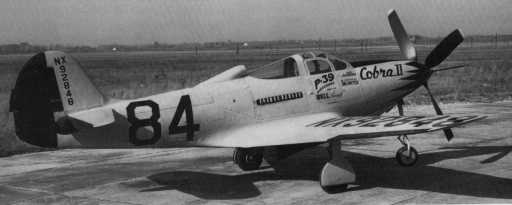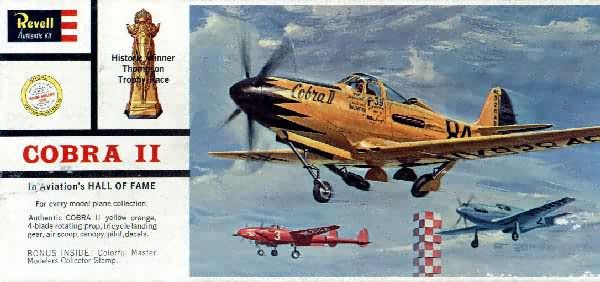Originally posted by hogenbor
I also heard that after the war the P-39 was succesfully used for air racing. What races and how the plane was set up (maybe the way CVH suggested?) I do not know. I suspect Widewing will know this kind of stuff.
Besides, the P-39 is darn pretty airplane 
Here's some info on the post-war racing P-39s.

1/48th scale model of the 1946 Thompson Trophy winner. Tony LeVier's P-38 finished 2nd, a P-51B finished 3rd.
From Baugher:
After the war was over, the USAAF rapidly disposed of most of its Airacobras, with most being scrapped during 1946. However, a few were sold as surplus on the commercial market.
Some surplus P-39s ended up on the postwar unlimited racing circuit. Perhaps the best known of these were a pair of surplus P-39Qs named Cobra I and Cobra II. They were originally P-39Q-10s 42-20733 and 42-20869 respectively. Bell test pilots Chalmers "Slick" Goodlin, Alvin M. "Tex" Johnston, and Jack Woolams prepared these planes for entry into the Thompson Trophy race which was to be held over the Labor Day weekend in Cleveland, Ohio in 1946. They were lightened by the removal of all military equipment, and they received uprated Allison V-1710-135 (G4) engines taken from P-63s and were fitted with four-bladed propellers. When so equipped, they were capable of achieving speeds as high as 420 mph at low altitude.
On August 29, both planes qualified for the race. Untortunately, before the race was run, Cobra I was lost on August 30, 1946 over Lake Ontario, killing the pilot, Jack Woolams.
Cobra II (flying under the civilian registration of NX92848) went on to win the 1946 Thompson Trophy air race, with Tex Johnston at the controls, at an average speed of 373 mph over the 300-mile course. Cobra II raced again in the 1947 Thompson Trophy race, finishing 3rd. It raced yet again in the 1948 Thompson trophy race, but was unable to finish owing to engine difficulties.
Cobra II did not race again. It sat derelict for many years and was sold to Ed Maloney in 1960. He restored it to wartime colors and displayed it in his museum in Claremont, California. It was purchased in 1967 by Mike Carroll for use in an attempt to break the world piston-engine speed record, held at that type by the Messerschmitt Me 209. He installed a highly-modified V-1710-CG engine rated at 2850 hp, driving a four-bladed propeller. Four feet of outer wing were removed from each tip. Unfortunately, Cobra II crashed on August 10, 1968 during a test flight, killing pilot Mike Carroll.
P-39Q-15 (44-2433/NX57521) was flown in the 1946 National Air Races by Earl Ortman. This plane is now in storage at the NASM facility at Silver Hill, Maryland painted with the name Galloping Gertie.

A photo of the Cobra II.

Revell's model kit box.
My regards,
Widewing